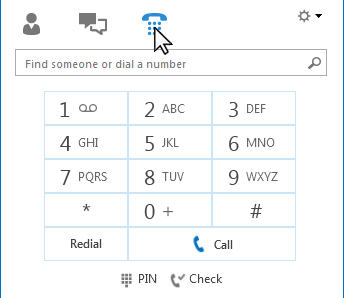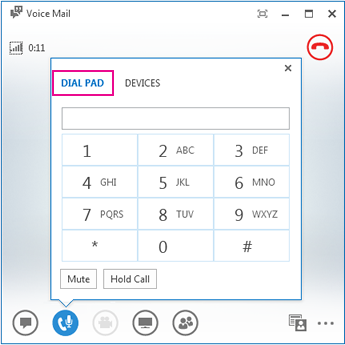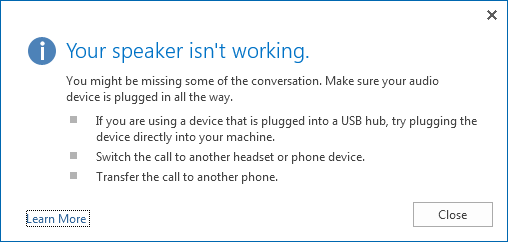FAQ about audio and video
This article contains frequently asked questions about using Lync audio sound (voice) and video.
Send us feedback if your question isn't answered.
In this article
How do I know my devices are set up correctly?
Lync automatically detects your audio and video devices. However, we recommend that you check before making a call or joining a meeting, to make sure they are set up correctly.
See Set up and test Lync audio and Set up and troubleshoot Lync video for instructions.
Can I use Lync to make a call?
Yes, a Lync call is made from your computer to the computer of someone else who is using Lync or Skype. The call is made via computer audio. A Lync call rings at all the recipient's devices that are enabled for Lync, such as desktop and laptop computer.
For details about communicating with external contacts, see Add an external contact in Lync. For more information, see Make and receive a Lync audio call.
Where is the Lync dial pad and how do I use it?
Not all Office 365 users have a dial pad. If you do, you can use it enter a PIN or make a selection for an automated voice system on a call and open it from two places:
-
In the Lync main window, on the Phone tab.

-
In the conversation window that opens when you start a call. Pause on the phone/mic icon to see the dial pad.

Can I make a call without adding someone to my Contacts list?
Yes. You can search for a person by typing their name in the search box. In the search results, pause on their picture, and then click call.
How can I add my numbers to my contact card?
Add phone numbers to your contact card so that people know how to reach you by phone. The numbers on your contact card are visible to your Lync contacts based on the privacy relationship you have with them. For details about who sees what, see Control access to your presence information in Lync.
-
In the Lync main window, click the Options button, and then click Phones.
-
Under My phone numbers, click a box, and type your number. Use only the digits 0123456789 and no parentheses or hyphens. When adding international numbers, type the + sign and then the country code followed by the local number.
-
Select the boxes next to the number(s) that you want to show on your contact card.
For more information about adding phone numbers to your contact card, see Set Phones options.
Why am I having audio problems?
If there's a problem, a notification is displayed in the conversation window or the Lync main window. You can click the notification for more information or suggested solutions.
For example:

If you're not getting sound, check that:
-
Your speakers are turned on, both in Lync and your computer, and the speaker volume is high.
-
Your phone handset is on the cradle (if you're using Lync Phone Edition).
-
The device you're using is selected on the Devices tab, (pause on the phone/mic icon, and click the Devices tab).
What can I do to improve device audio quality?
-
Use a high quality audio device, replace any defective or damaged devices, and run the set up to make sure it works correctly. We recommend you use a device listed in Phones and devices qualified for Microsoft Skype for Business (Lync).
-
It's important that a noise-canceling microphone is positioned close to the mouth, approximately less than 1 inch away from the mouth, to filter out unwanted background noise.
-
Most headsets have a button to adjust the volume depending on which audio device the headset is connected to. If you or other callers hear a buzzing noise, make a test call, and then adjust the settings on the headset until the buzzing noise is gone.
-
If you're using the speaker on your phone running Lync Phone Edition and callers complain about background noise, make sure that the phone is on a flat surface, and you are close to the phone.
-
If you're using two separate devices for audio (such as desktop speakers and camera), try to place them at an appropriate distance from each other to minimize echo.
-
We recommend that you don't make calls over a wireless connection, virtual private network (VPN), or remote access service (RAS) connection.
No comments:
Post a Comment